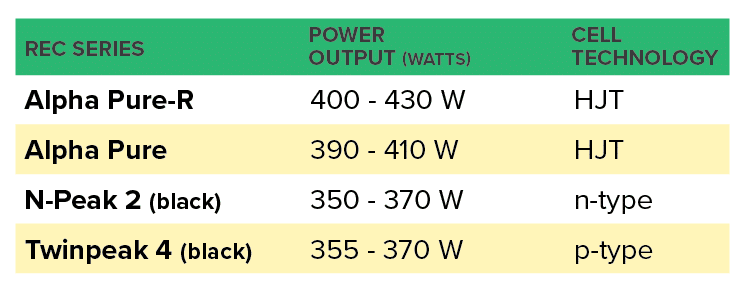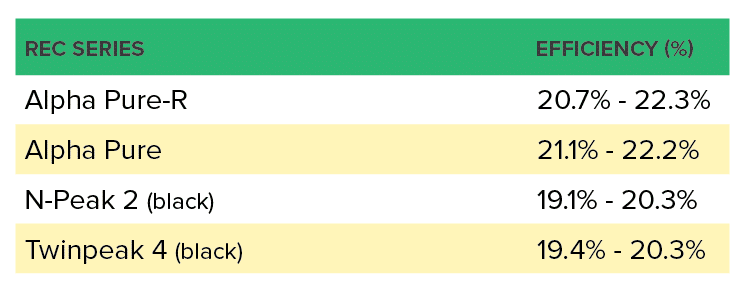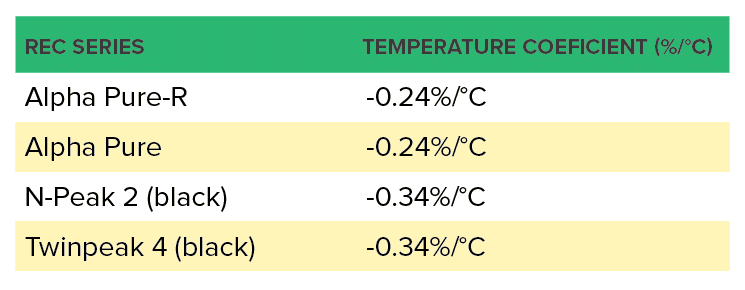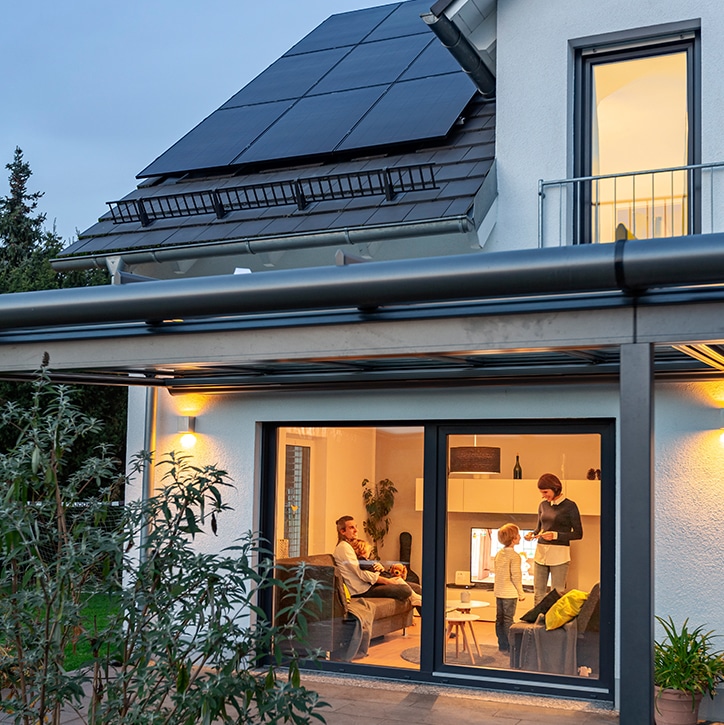Let’s Get to Know REC
REC Group is a leading solar panel manufacturer based in Europe. Founded in Norway in 1996, the company has expanded its operations globally, with a significant presence in the United States, Asia, and Australia.
A key innovation by REC Group Solar was the introduction of half-cut cell technology in 2014. This technique involves splitting solar cells into two parts, which significantly improves the overall efficiency of solar panels. This breakthrough has been instrumental in advancing solar panel technology.
REC Group’s primary manufacturing facility is located in Singapore, where they produce a range of solar panels for various applications. In 2022, the company launched its latest product line, the Alpha Pure-R series, further expanding their offerings.
Currently, REC Group produces four main types of solar modules specifically designed for residential use:
- Alpha Pure-R
- Alpha Pure
- N-Peak 2
- Twinpeak 4
These panels have gained popularity due to their consistent performance and high-quality construction. As a result, REC solar panels have become a frequently recommended and selected option at solar installation companies like 8MSolar.
The success of REC Group demonstrates the growing importance of renewable energy technology and the global nature of the solar industry. Their journey from a Norwegian startup to a world leader in solar panel production illustrates the rapid advancement and increasing adoption of solar energy solutions.
What kind of REC solar panels can you get?

The offerings from REC are diverse, providing a range of top-grade solar panels for both residential and commercial use (though they’re not a standard pick for utility-scale systems). The company currently highlights the high-power Alpha Pure and Alpha Pure-R series as excellent choices for homeowners:
- REC Alpha Pure-R
- REC Alpha Pure
- REC N-Peak 2
- REC Twinpeak 4
All these solar panel series use monocrystalline technology, employing a single silicon crystal rather than multiple fragments found in polycrystalline panels. While slightly more expensive, these panels offer improved efficiency and better adaptation to temperature changes.
REC’s N-Peak 2 panels use n-type silicon, while Twinpeak 4 panels use p-type silicon. N-type silicon incorporates phosphorus, whereas p-type silicon is boron-based. The Alpha series from REC delivers higher power compared to the N-Peak and Twinpeak series, thanks to heterojunction (HJT) solar cell technology. This technique provides superior power density, efficiency, performance, and longevity. The “pure” label indicates these panels are lead-free, resulting in a smaller carbon footprint and no hazardous leaks during recycling.
Let’s look at how the power output and cell technology of different REC panels stack up against each other:


How do REC solar panels measure up?
When assessing solar panel quality, there are four primary metrics to consider: efficiency, performance, warranties, and cost. Let’s delve into what each of these entails and see how REC solar panels fare against the competition in the solar industry.
Efficiency
The term “solar panel efficiency” denotes a panel’s ability to capture sunlight and transform it into usable electricity. Given similar conditions, a high-efficiency panel will yield more electricity than a less efficient panel of the same size. Therefore, panels with higher efficiency ratings are generally preferred.
The efficiency of your REC solar panels will be contingent on the specific model you select. The most efficient panel boasting 22.8% efficiency. In comparison, REC’s product line boasts an efficiency rating between 19.1% and 22.3%:


Performance (temperature coefficient)
The temperature coefficient is a key measure of a solar panel’s performance in non-ideal conditions. Solar panels function best when cool, around 25°C (77°F). This coefficient shows how much a panel’s output decreases as temperature rises.
For every degree above 25°C (77°F), a panel’s electricity production drops by its temperature coefficient. REC’s Alpha Pure-R panels have a coefficient of -0.24%/°C, the best in their range. This means:
At 26°C (79°F), output decreases by 0.24%
At 35°C (95°F), output decreases by 2.4%
Since solar panels often face high temperatures, a lower coefficient is preferable. REC panels’ coefficients range from -0.34 to -0.24.


Warranties
Just as when you’re purchasing a television or a vehicle, the manufacturer should back their product with a robust warranty when buying solar panels. The materials warranty of a solar panel (also known as the product or equipment warranty) is an assurance from the manufacturer that they’ll replace your panel if it fails due to manufacturing defects or environmental factors.
REC provides a 25-year product warranty under their ProTrust warranty on any panels installed by a REC Certified Solar Professional installer, a standard in line with other top solar panel companies such as Panasonic, SunPower, and Q CELLS. However, if you opt for a solar installer that isn’t REC-certified, you’ll only receive a 20-year product warranty, but don’t worry 8MSolar is REC-certified! They also furnish a 25-year power warranty, guaranteeing that their panels will still generate at least 86% to 92% of their initial output by the end of the warranty period, depending on the product series:
We suggest checking out our comprehensive review of REC’s warranty and see how it measures up to other leading solar manufacturers.


How Much to REC Solar Panels Cost?
For many homeowners, the ultimate deciding factor when choosing solar equipment is the cost. The total amount you pay for a solar energy system with REC’s solar panels will depend on other equipment (like inverters and mounts) used in the installation and the features of your roof.
As of now, the average price of solar panels (across all brands and types) ranges from $2.40 to $3.22 per watt. That said, REC solar panels are usually priced slightly higher than the average, reflecting the premium technology and efficiency they offer. On average, you could expect to pay between $2.75 to $3.50 per watt for REC solar panels before applying any incentives or rebates.
Please note that the costs mentioned here are just the average costs of the solar panels themselves and don’t account for other solar equipment costs like inverters, mounting hardware, labor costs, permit fees, potential tariff fees, and other factors that could affect the total cost of a solar power system.
The best way to know precisely how much a solar energy system will cost with REC panels is to call 8MSolar for a quote.
Are you Ready for REC?
Even though REC solar panels might come with a slightly higher initial cost, the investment could pay off in the long run. With their high efficiency, robust warranty, and excellent performance under various conditions, REC solar panels can provide a great return on investment through higher electricity production over the system’s lifetime.
Moreover, the total cost of your solar energy system can also be brought down significantly through various solar incentives. In the U.S., the federal Investment Tax Credit (ITC) allows you to deduct up to 30% of the cost of your solar energy system from your taxes. There are also many state-level incentives and rebates that can help reduce the cost of going solar.


REC Group is a well-established player in the solar industry, and their solar panels are a great choice for homeowners looking for a high-quality, reliable, and efficient solar solution. While they might be a bit pricier than some other options, the long-term benefits and return on investment could make REC solar panels a wise choice for your solar energy system. If you think REC is right for you, and you are looking for a solar installer in North Carolina, give the experts at 8MSolar a call.
If you would like to learn more, check out our article on the equipment 8MSolar carries.


